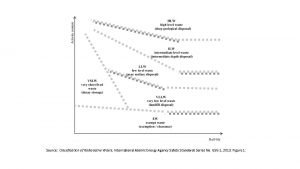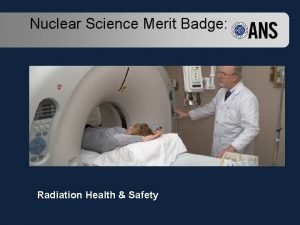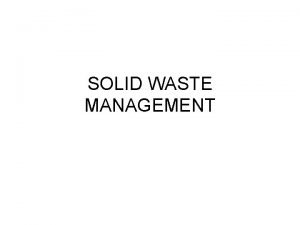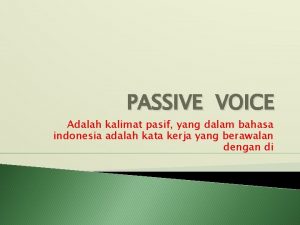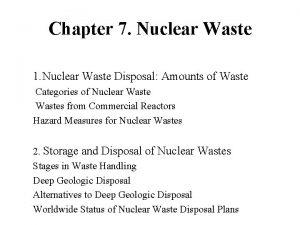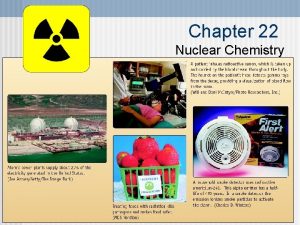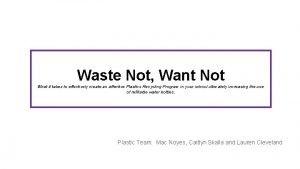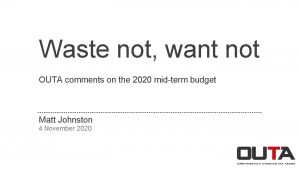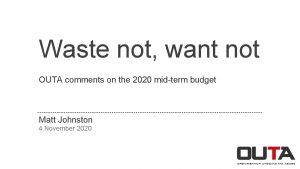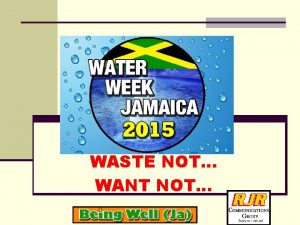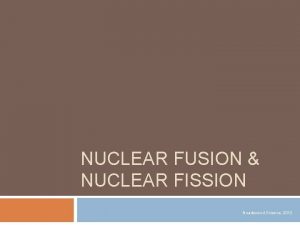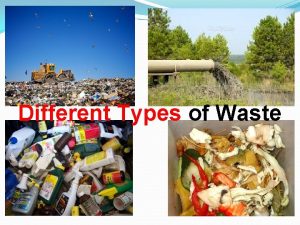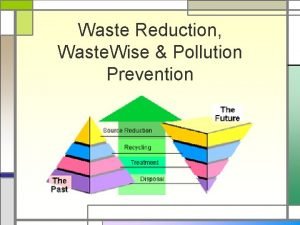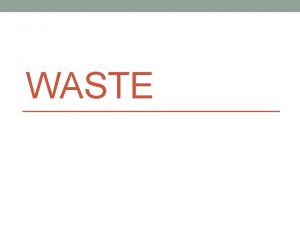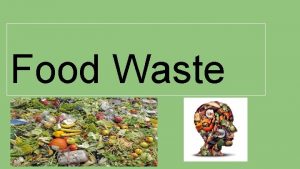Waste Not Want Not Nuclear Science Teacher Workshop














- Slides: 14

Waste Not, Want Not Nuclear Science Teacher Workshop May 19, 2018 Atlanta, Georgia Explore the nuclear fuel cycle and learn about what happens to spent nuclear fuel. Did you know that a soda cansize of nuclear fuel is all that you would need to power your entire lifetime of electricity needs? Activities will be provided for students to make comparisons of the waste (and byproducts such as carbon) from the different types of electricity generation sources.

The Nuclear Fuel Cycle Above: This is cake that is yellow. Not yellowcake. Right: Uranium yellowcake. 2

What is nuclear waste? It’s a solid! 3

Is it safe? XKCD Rocket Powered Train Airstrike Puncture 4

Why do people talk about nuclear waste so much? Politics! 5

How does nuclear compare? 6

Reduce, reuse, recycle 7

8

Classroom Activity Guess Relative Lifecycle Carbon Emissions ▪ Each cup represents a different energy source: coal, gas, hydro, nuclear, solar, wind ▪ The black sand represents greenhouse gas emissions (waste!) Units: grams of CO 2 per kilowatt-hour ▪ Consider lifecyle carbon emissions (direct emissions from burning and indirect emissions from construction, etc) ▪ Place in order from high to low ▪ Fill up each cup with the relative amount of carbon emissions (you are making a histogram graph) 9

Classroom Activity - Solution 10

Education Standards Earth and Space Sciences Next Generation Science Standards HS-ESS 3 -3. Create a computational simulation to illustrate the relationships among the management of natural resources, the sustainability of human populations, and biodiversity. Activity: Develop a spreadsheet model with inputs such as cost of mining, cost of waste management, per-capita consumption, etc. Example: here or read this report (pg 37) Play The Energy Challenge 11

Education Standards Life Sciences Next Generation Science Standards LS 2. B: Cycles of Matter and Energy Transfer in Ecosystems Matter cycles between the air and soil and among plants, animals, and microbes as these organisms live and die. Organisms obtain gases, and water, from the environment, and release waste matter (gas, liquid, or solid) back into the environment. Activity: Discuss different types of waste (solid, liquid, gas) from electricity generation types and whether they dissipate 12

Education Standards Earth and Space Sciences Next Generation Science Standards ESS 3. C: Human Impacts on Earth Systems Scientists and engineers can make major contributions by developing technologies that produce less pollution and waste and that preclude ecosystem degradation. Activity: Discuss the climate puzzle. View films Pandora’s Promise and/or The New Fire Learn more about fusion 13

14
 Lesson 15 nuclear quest nuclear reactions
Lesson 15 nuclear quest nuclear reactions Fisión nuclear vs fision nuclear
Fisión nuclear vs fision nuclear Radioactive nuclear waste
Radioactive nuclear waste Willful waste makes woeful want
Willful waste makes woeful want Nina’s favorite subject is science
Nina’s favorite subject is science Bsa nuclear science merit badge
Bsa nuclear science merit badge Erf for teachers
Erf for teachers Good afternoon student
Good afternoon student Solid
Solid Vocabulary workshop level d unit 1
Vocabulary workshop level d unit 1 Science teacher
Science teacher The court will try the case next week passive voice
The court will try the case next week passive voice Social science vs natural science
Social science vs natural science Branches of biology
Branches of biology Natural science vs physical science
Natural science vs physical science


